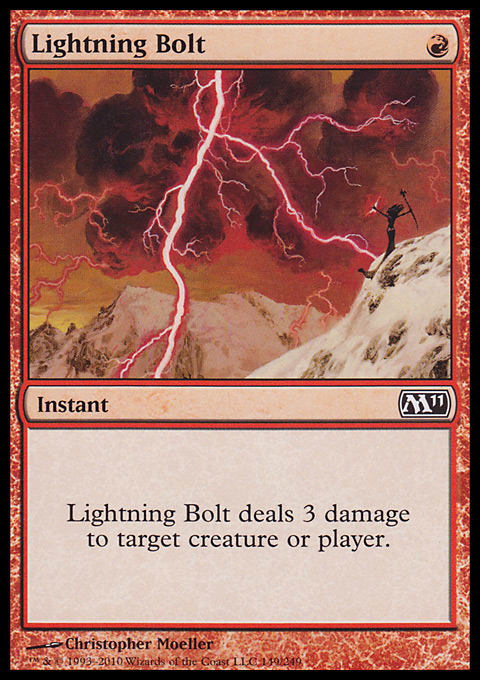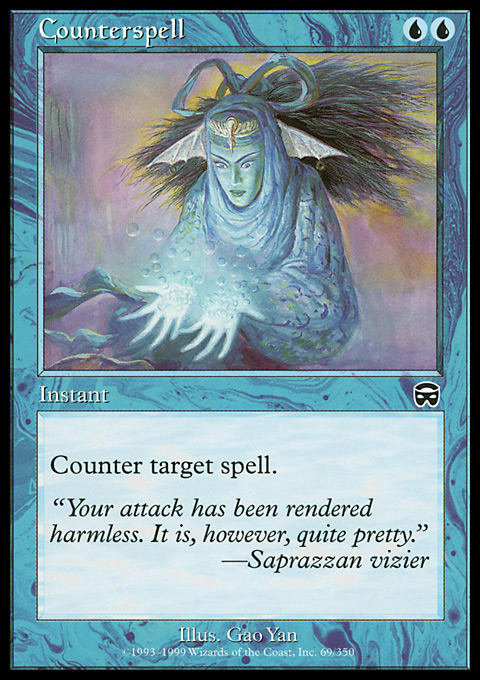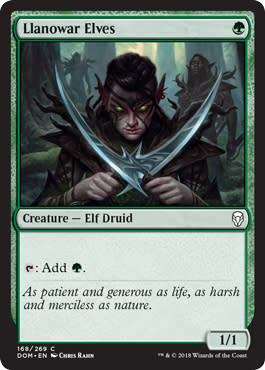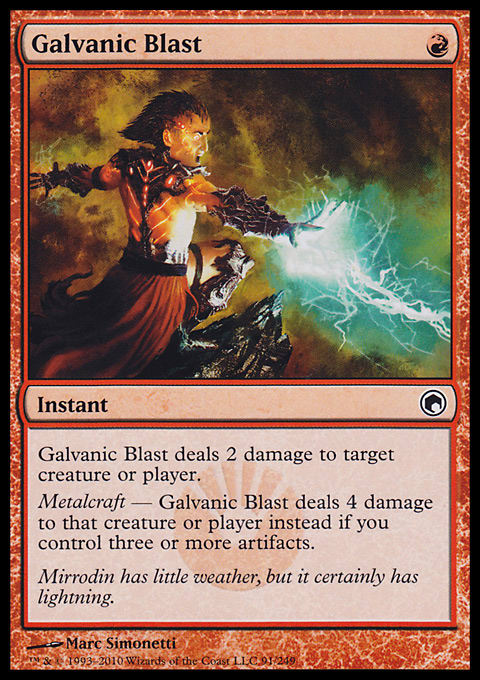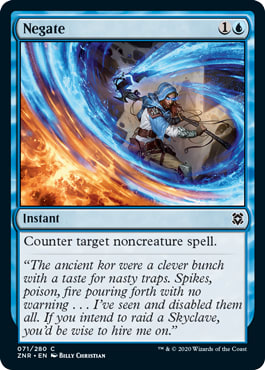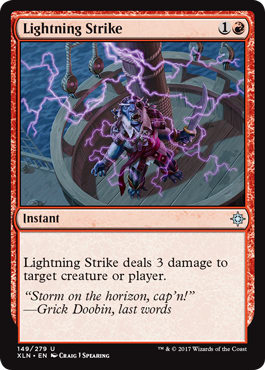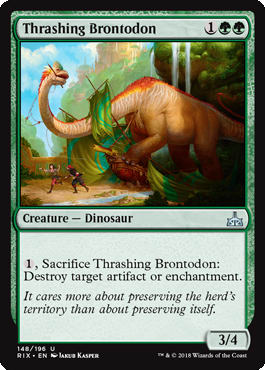When you think about Magic, it's easy to think of the game's all-time iconic cards.
Even with the game having over 20,000 unique pieces, certain pieces just stand out from a crowd. This can be for many reasons; power level, nostalgia, ubiquity, flexibly, and more. When you cast a Lightning Bolt you feel a certain way and each of these cards has a powerful effect that makes Magic feel like, well, Magic.
However, the real beauty of Magic is that it is in a state of constant change. For over 25 years we've seen cards come and go, with formats always in flux thanks to old cards rotating out and new cards being printed. Even if the cards change however, both the utility and the essence of each color remains intact.
We may not get Lightning Bolt, but we get the essence of Lightning Bolt seen through a new lens. Maybe it's a different take on the effect like Incendiary Flow, or a take on the effect that is thematic with the set it is in like Fiery Temper and Galvanic Blast. Each new iteration forces us to reevaluate what we knew about Lightning Bolt while placing it contextually among the new cards now available.
Yet, there is a fear of complexity creep when you move away from the basic and into the more nuanced.
This is a large part of why we have Core Sets; Magic is already an unbelievably complicated game and it is important to make sure it is not needlessly so. Not every card needs to have a wall of text, which allows the simpler cards to provide foundations for the more "interesting" cards. As a result of this however, there have certainly been times where formats have lacked a simple effect a color usually has access to, either because of omission or because that format's variant fell short when it came to power level.
This has always interested me, so when friend, commentator, and game designer Patrick Sullivan took to twitter to gather questions for his usual mailbag article the question just sort of came out.
You can select one reprint of each color to always be legal in Standard. What are they and why? Bonus points if you want to do a colorless card and land as well.
— Jim Davis (@JimDavisMTG) November 17, 2020
I encourage everyone to go read Pat's take on the question, but after I asked, I had a number of responses both giving their opinion as well as asking mine.
Sounds fun to me!
Optimal Evergreen
So, let's just put Lightning Bolt in every set and call it a day, right?
Not so fast there sparky. If a card is going to be evergreen, that is always available, it needs to walk a very fine line.
If it is something like Lightning Bolt that is extremely flexible and powerful, it will simply end up defining the format. Lightning Bolt is often one of the most, if not the most, commonly played cards in any format it is in. If you are playing red you need to find a good reason not to play Lightning Bolt, rather than a reason to play it.
If Lightning Bolt is always legal, the game starts to look like Lightning Bolt: The Gathering rather than Magic. However, this can go too far the other way as well.
Let's say we decide to make Open Fire evergreen instead. After all, it's much worse than Lightning Bolt while still being a reasonable Limited card, right? The issue is that while it would be a high pick in Limited, the format would need to be abnormally weak or have a serious lack of Red removal for anyone to ever put Open Fire in their Constructed decks. The "expert set" variations would likely be better, making Open Fire basically worthless.
With our power level target established, we need to think about the effect of these cards.
Primarily we are going to be looking at answers rather than threats. Much to the same tune of Lightning Bolt, if Llanowar Elves, Tarmogoyf, or Goblin Guide are in every set, too many games will end up revolving around them. Threats define what a deck sets out to do, while answers are more universal in their application. Furthermore, having a set of constant answers always available in a format provides a safety valve if things ever go wrong. Maybe they missed high on Wilderness Reclamation or Teferi, Hero of Dominaria, but if there are good cards players can turn to as answers it isn't so bad.
There's also a level of elegance here as well. Many basic answer cards are iconic because what they do is simple and conveyed in very few words. The effect plus the cost and speed are just right to provide for a good answer that feels right.
So, let's get started!
Banishing Light is the ideal White removal spell.
It is extremely flexible, but also clunky at three mana and sorcery speed. It exiles, which feels very White, and is also vulnerable to being removed which is very much in line with how many White removal spells work. The card goes to jail, but if your opponent can figure out how to get it out it will usually be bad for you.
Banishing Light is simple, easy to parse, and plays well, while not being overtly powerful on rate. When Banishing Light has been legal in Standard, it has seen the full range of zero to four copies in various White decks. And perhaps most importantly, it's a very flexible answer if there's some odd permanent that is causing decks problems and the format currently lacks reasonable answers.
Honorable Mentions: Disenchant, Raise the Alarm
There's a good reason that Negate has been printed about a zillion times since its initial printing in Morningtide. Put mildly, Negate is the perfect safety valve against control, combo, and many linear decks.
It feels very bad when you play against someone who's playing a creatureless control or enchantment deck and you look down forlornly at your hand of Glass Casket, Fatal Push, and Eliminate. There are formats where Negate is maindeckable and there are formats where your opponent may have zero maindeck targets for it. The opportunity cost is there, as are the rewards when it works.
Negate is the perfect answer; it's good when it's good, bad when it's bad, and an excellent safety valve.
Honorable Mentions: Opt, Hieroglyphic Illumination
Honestly? Just cut and paste everything I said about Negate.
Duress is a little less nimble and maindeckable because Negate will often play better if your opponent has very few targets, but all the same thoughts apply. Duress handles all the control and unfair decks and it's a great safety valve for a format to have. It's also interesting to play with and feels like the perfect Black card.
If there's a deck that pops up that is annoying, it's a good bet that Negate or Duress can help you pick it apart.
Honorable Mentions: Disfigure, Bloodchief's Thirst
Red is a bit weird because of how its reactive cards can be used proactively as well. This means that Lightning Bolt or Shock are never dead and can fit into the game plan of "just kill your opponent" much more easily than something like Banishing Light or Negate. However, it is just too important to Red's identity to not have a good burn spell available at all times.
You can use Lightning Strike defensively or offensively, meaning it has flexibility between decks, but it's also not too limiting. Lighting Strike does put a bit of limit on what kind of variations you can do in your expert sets (you can't have too many Rift Bolts or Skewer the Critics legal at once) but the Chandra's Triumphs and Scorching Dragonfires of the world usually end up as sideboard cards anyway. As a note I think Abrade is great but the incidental damage to people trying to play artifacts fairly is too damaging to always be around.
This could easily be Shock, but there should always be one of the two legal.
Honorable Mentions: Shredded Sails, Mogg Fanatic
We've been seeing a lot of Thrashing Brontodon lately, which is another well placed evergreen-style card. It's simple, effective in size but not always maindeckable, and provides a good safety valve answer. Like most of the cards listed it is a card you could maindeck if the metagame warranted it, but won't necessarily want to most of the time.
It's also nice that it is just a good-sized body as well. Maybe you need to board out those extra removal spells against a control deck and just want to bring a threat in, or you just want a big blocker against Mono-Red. Thrashing Brontodon does a good job accomplishing many of these roles, whereas something like Reclamation Sage is more limiting.
Note that putting a ramp spell in this slot would be dangerous because of how it can end up defining an archetype.
Honorable Mentions: Cultivate, Giant Growth
Pithing Needle is a classically overrated card. Despite about as cheap and easy to cast as possible, it ends up being very awkward unless you have a specific purpose in mind when you put it into your deck or sideboard. There's too much risk in drawing it when your opponent doesn't draw the card you name, or worse having nothing good to name.
However, Pithing Needle is the perfect safety valve card.
Imagine if Pithing Needle was legal during Kaladesh Standard or War of the Spark Standard? Those formats were rife with powerful early artifacts and planeswalkers that were hard to deal with, which would have made having access to Pithing Needle to name Heart of Kiran, Teferi, Hero of Dominaria, Gideon, Ally of Zendikar, or Aetherworks Marvel a very nice option.
There will be many times where it doesn't see much play, but it's a great thing to have around.
Honorable Mention: Prophetic Prism
It took a few tries with Ghost Quarter and friends, but Wizards of the Coast really nailed it with Field of Ruin. Having lands that do things is awesome, as it makes mana flood less of an issue and puts more play into an area of your deck that normally doesn't do anything but cast spells. But if you make too many good lands, they can be very difficult to answer.
Enter Field of Ruin! Field of Ruin doesn't massively punish any player as far as mana development goes, but is powerful enough to see play even in Modern. And the fail state is either a colorless land or some slow mana fixing.
Field of Ruin is almost the perfect Magic Card.
Honorable Mention: Fabled Passage
Okay, I've already gone over this one so I won't repeat myself.
Wrapping Up
It's interesting to note that almost every card I talked about today is actually already in Standard, which means it's time for some props to Wizards of the Coast for the excellent foresight. It's very easy to drag them for all the blunders the last year or two, but those can at times overshadow the good things that are happening and these sorts of safety valves are definitely one of them.
And it shows! We've got a great Standard format right now where almost nothing feels unanswerable.
One of the most enjoyable things about deck-building is finding that perfect answer that isn't something so head smashingly obvious like Questing Beast. When that Shredded Sails or Thrashing Brontodon ends up being the perfect card to help swing your bad matchup it feels awesome!














